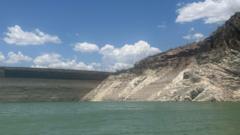The water crisis in Chihuahua, Mexico, has shifted into high gear as locals plead for divine intervention after enduring 30 straight months of drought. At Lake Toronto, farmers gather with a priest for prayer as the reservoir, once vital for agriculture, stands at a shocking 14% capacity. Rafael Betance, who has monitored La Boquilla Dam for over three decades, recalls a time when the area was submerged in water.
“Since the last overflow in 2017, we’ve witnessed a steady drop,” Betance lamented, identifying the critical numbers: 26.52 meters below capacity and diminishing year over year. As the drought intensifies, the situation has created friction with neighboring Texas, underpinned by a 1944 water-sharing agreement that mandates Mexico send 430 million cubic meters of water from the Rio Grande annually to the US.
In return, the US allocates around 1.85 billion cubic meters from the Colorado River to Mexico. However, Mexico has consistently failed to meet its part of the treaty, causing frustration to Texas farmers. Brian Jones, a farmer from Texas facing water shortages himself, remarks, "We're just asking for what's rightfully ours under the treaty." Tensions escalated under the Trump administration, with accusations that Mexico was “stealing” water and threats of tariffs if obligations were not met.
While Mexico’s President Claudia Sheinbaum acknowledged the shortfall, she adopted a conciliatory approach, recently transferring 75 million cubic meters to the United States, still far from the amount owed. The friction over water access is compounded by differing views on the 1944 treaty. Farmers in Chihuahua believe the agreement allows them to withhold excess water when local needs aren't met, citing ongoing drought conditions.
With crops reliant on vast water supplies, farmers across the border in Texas find themselves battling against water shortages too. The issue is further complicated by agricultural practices; many farmers in Chihuahua continue traditional, wasteful flooding methods, while some, like Jaime Ramirez, are adopting more sustainable techniques like modern sprinkler systems.
Despite varying farming practices, both sides face a common existential threat as drought conditions persist. Ramirez emphasizes the urgent need for conservation, warning of dire implications if the rains do not return soon. Meanwhile, Betance fears for the local economy as Lake Toronto's low levels threaten not just agriculture but local tourism and aquatic life as well.
The ongoing tension and disagreements illustrate a need for an evolved water-sharing arrangement that takes into account modern realities and climate challenges. On both sides of the border, individuals are caught in a precarious position, with livelihoods hanging in the balance as they all plead for rain and a sustainable solution.




















